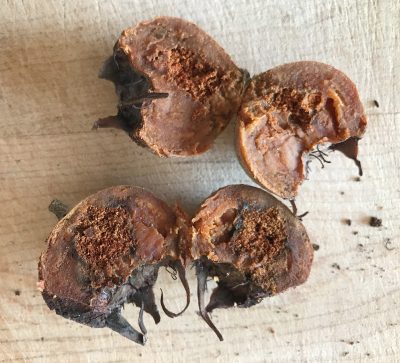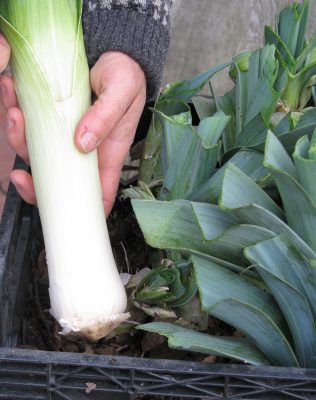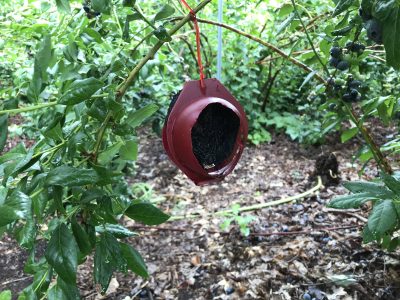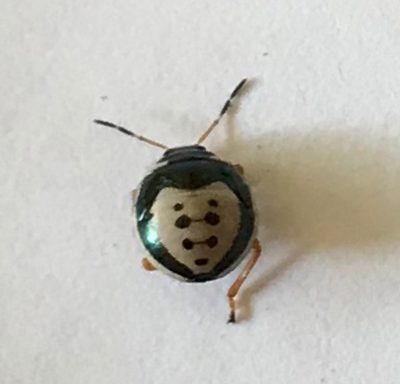TASTING AND TIDYING, OR NOT
Fruit Heaven
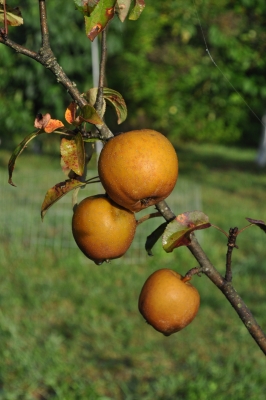
Hudson’s Golden Gem apple
I remember a few years ago of having a most fruitful — and I mean this very literally — experience visiting one of the USDA’s germplasm repositories. “Germplasm repository” doesn’t sound like the kind of place anyone would want to be, but these USDA repositories are, in fact, sunny, colorful places, often redolent with enticing aromas. In the case of the one I visited, the aroma was of ripening apples.
Germplasm is the stuff that gives rise to an organism, and the USDA has set up repositories around the country to house various kinds of plants. Each repository is situated where a particular group of plants grows well. So Davis, California is home to the repository for figs, pomegranates, and Asian persimmons; Corvallis, Oregon is the repository for pears, gooseberries, and mint; and Geneva, New York, where I visited, houses the collections of apples and American-type grapes. (My own gooseberry collection helped build the gooseberry collection at Corvallis about 30 years ago.)
Taking into account seed collections and other, related work, these repositories maintain over 20,000 accessions of plants representing over 300 species. Germplasm from these collections is available to scientist and other interested citizens, which is how I obtained grafting wood to make most of the rare varieties of apples and pears that I grow.
So there I was — a fruitophile — standing with clipboard in hand and camera in pocket in in a field of apple trees, each one a different variety. My mission: Photograph and collect 3 to 4 samples of a couple of dozen varieties. What sweet labor! (I had previously contacted the repository staff and received permission).
Up and down the rows I went, photographing, collecting, and, of course, tasting. Apples have been cultivated for so long and are so popular a fruit that it’s no wonder that such great variation exists in the fruits’ appearances and flavors. Flavors include anise-flavored Ellison’s Orange, sweet Mollie’s Delicious, spicy-tart Cox’s Orange Pippin, and everything in between and beyond. The range in color goes from gray-brown Pomme Grise to cheery red-splashed yellow King of the Pippin. And then there are variations in fruit size and shape and, less obvious, characteristics such as pest resistance, productivity, and cold tolerance.
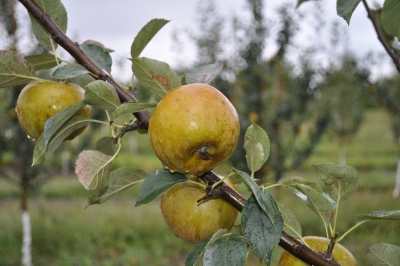
Ashmead’s Kernel apple
Most important, to me, is flavor. I should have brought a palate cleanser because after a while all the varieties were beginning to taste like . . . well . . . apples. Nonetheless, two varieties that I did not grow did stand out for flavor; I ordered grafting wood of Hudson’s Golden Gem and Pitmaston Pineapple to graft onto trunks of my Ingrid Marie trees once I lop their tops off.
After the apples, there were grapes to photograph and sample.
Tidy Not
Boy, would I love to tidy things up with some pruning now. The Golden Celebration rose bush would look nicer in coming months with those couple of tall, gawky stems cut off or back.

Grape and hardy kiwi stems are reaching out all over the place, grabbing onto each other and anything else they can wrap around.
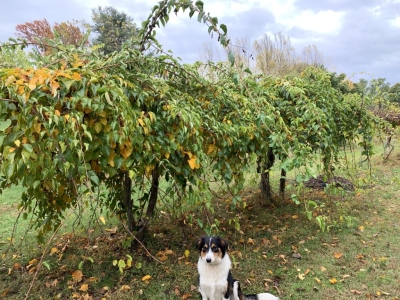
The pear trees have a nice spreading form — except for watersprouts shooting vigorously skyward from the uppersides of some of the spreading branches. How nice it would be to cut these plants back now rather than in spring.
But I’m going to restrain myself from doing any pruning. As stated in The Pruning Book (by me!), “Although immediate regrowth rarely occurs after late summer or autumn pruning, cells right at the cut are stirred into activity to close off the wound. Active cells are liable to be injured by cold weather, which is a reason to avoid pruning in late summer or autumn except in climates with mild winters or with plants that are very hardy to cold.”
Gooseberries and currants are super cold hardy plants and begin growth relatively early in spring. All of which makes a good case for pruning those plants now.
And a Case for Not Tidying
Rather than prune, a good place to re-channel that “tidy everything up” urge is in the vegetable and flower garden.
Cleaning up is one way to lessen pest problems next year. As I pulled out spent bush bean plants, I gingerly placed them into the garden cart and, from there, onto the compost pile, trying not to disturb the resident bean beetles. Those bean beetles had hoped to spend the winter on site, to emerge next spring and lay eggs on next year’s bean plants. I’m hoping to “cook” as many of them as possible in the compost pile.
Tomato plants are looking a bit ragged even though they’re still bearing some tomatoes for fresh eating. Gathering up all stems, leaves, and old fruits and composting them reduces the inoculum load of diseases such as early blight and septoria leaf spot. Left in place, they would spend winter out in the garden ready to infect next year’s plants. It’s not a question of eradication, which isn’t possible, but of balance.

Cutting down old peony stems and composting them takes inoculum for next years botrytis disease off-site. Left to infect plants next spring, botrytis could keep peony flower buds from unraveling.
As Charles Dudley Warner wrote over a hundred years ago (in My Summer in the Garden, which I highly recommend and is much more than a gardening book), “the closing scenes are not necessarily funereal . . . a garden . . . goes into winter-quarters . . . neat and trim . . . so that its last days shall not present a scene of melancholy ruin and decay.”
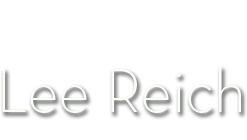

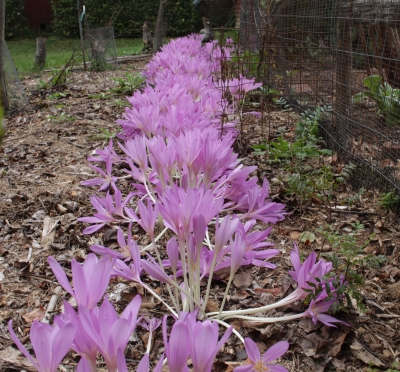

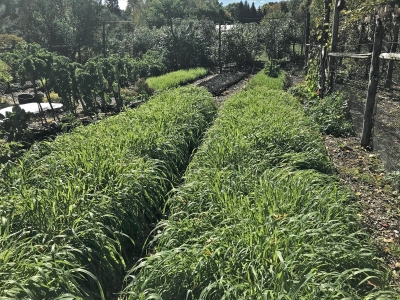

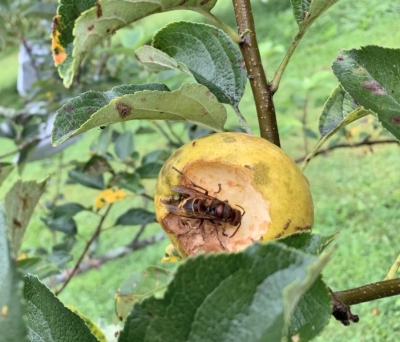
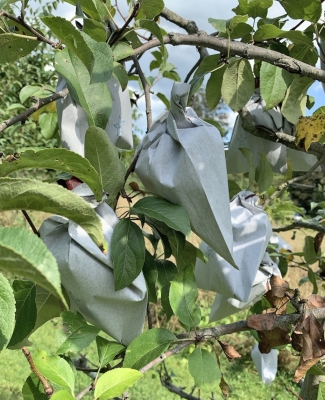
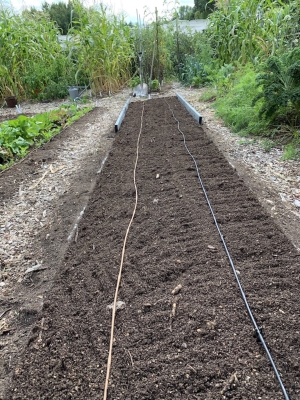
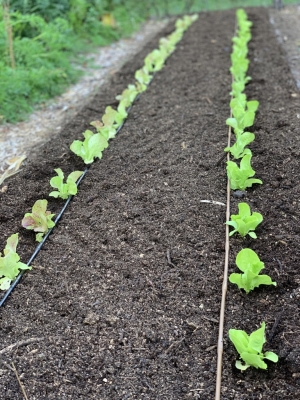
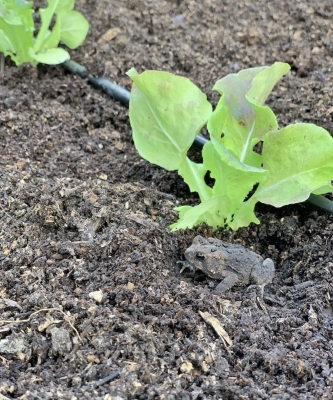
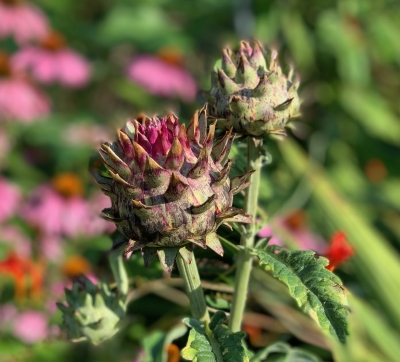
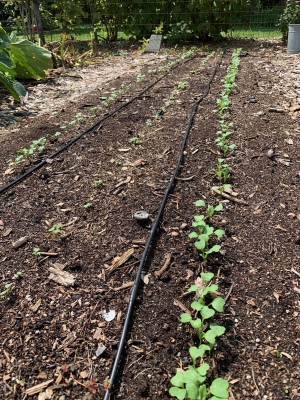
 The flavor hints of artichoke, a close relative. None the less, for me the flavor was awful and the stalks were tough. (Cardoon is usually covered to blanche them a few weeks before harvest. Blanching did not make mine more edible.)
The flavor hints of artichoke, a close relative. None the less, for me the flavor was awful and the stalks were tough. (Cardoon is usually covered to blanche them a few weeks before harvest. Blanching did not make mine more edible.)
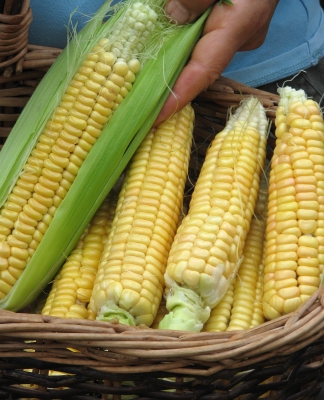

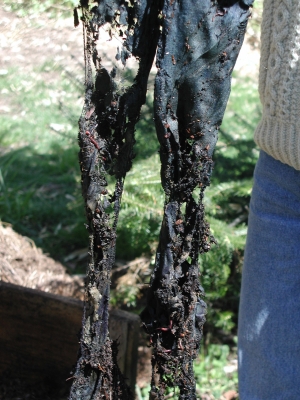
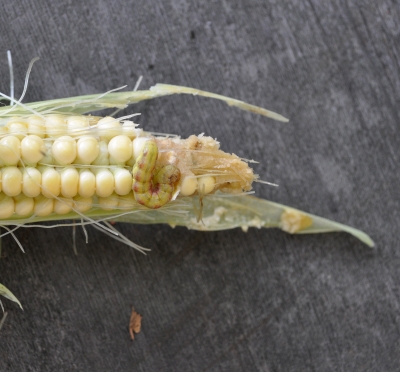



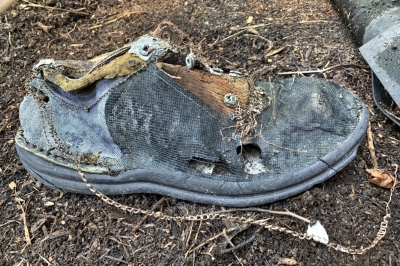 Occasional, light sprinklings of soil add bulk to the finished mix. Occasional, sprinklings of ground limestone keep planted ground, final stop for the compost, in the right pH range.
Occasional, light sprinklings of soil add bulk to the finished mix. Occasional, sprinklings of ground limestone keep planted ground, final stop for the compost, in the right pH range.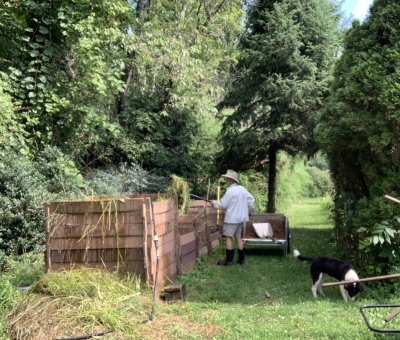
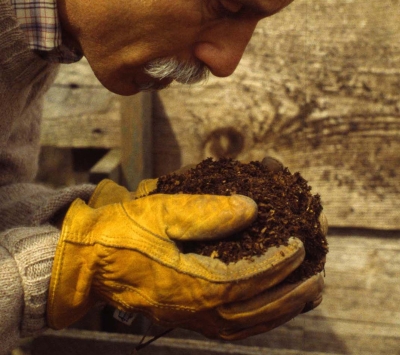
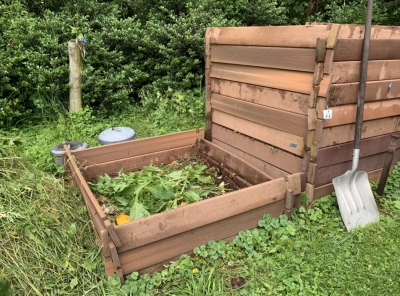
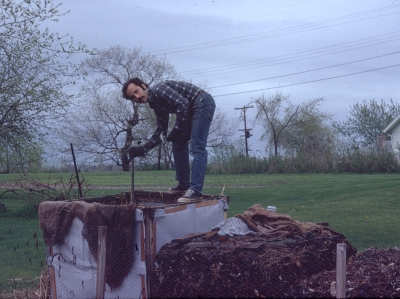 The next bins weren’t bins but just carefully stacked layers of ingredients, mostly horse manure, hay, and garden and kitchen gleanings. And then there was my three-sided bin made of slabwood.
The next bins weren’t bins but just carefully stacked layers of ingredients, mostly horse manure, hay, and garden and kitchen gleanings. And then there was my three-sided bin made of slabwood.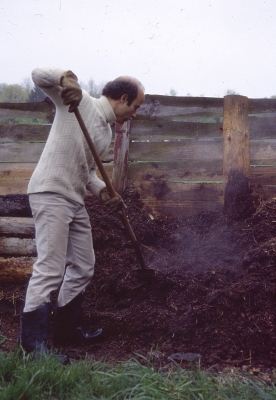
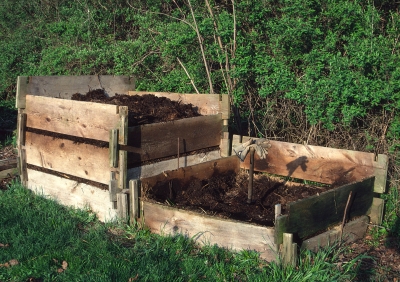 Which brings me to my current bin which, now, after many years of use, I consider nearly perfect. Instead of hemlock boards, these bins are made from “composite lumber.” Manufactured mostly from recycled materials, such as scrap wood, sawdust, and old plastic bags, composite lumber is used for decking so should last a long, long time.
Which brings me to my current bin which, now, after many years of use, I consider nearly perfect. Instead of hemlock boards, these bins are made from “composite lumber.” Manufactured mostly from recycled materials, such as scrap wood, sawdust, and old plastic bags, composite lumber is used for decking so should last a long, long time.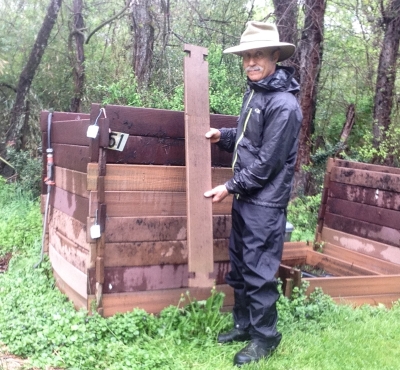 When finished, I ripped one board of the bin full length down its center to provide two bottom boards so that the bottom edges of all 4 sides of the bin would sit right against on the ground.
When finished, I ripped one board of the bin full length down its center to provide two bottom boards so that the bottom edges of all 4 sides of the bin would sit right against on the ground. Before setting up a bin, I lay 1/2” hardware cloth on the ground to help keep at bay rodents that might try to crawl in from below.
Before setting up a bin, I lay 1/2” hardware cloth on the ground to help keep at bay rodents that might try to crawl in from below.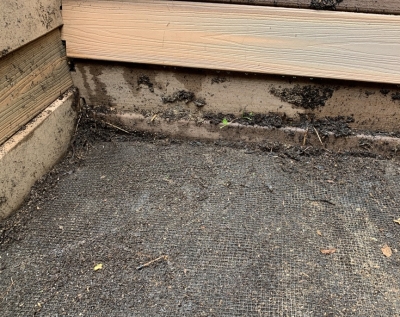 With the Lincoln-log style design, the bin need be only as high as the material within while the pile is being built, and then “unbuilt” gradually as I removed the finished compost.
With the Lincoln-log style design, the bin need be only as high as the material within while the pile is being built, and then “unbuilt” gradually as I removed the finished compost.
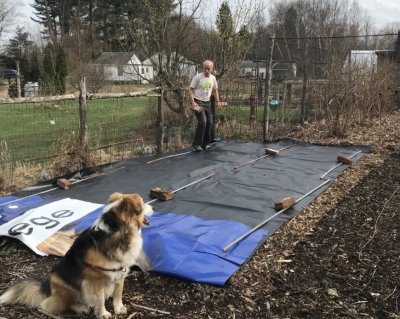 Actually, that insidious blackness covering my beds is black vinyl. But that’s beside the point. Its purpose, like the black plastic against which I’ve railed, is to kill weeds. Not that my garden has many weeds. But this time of year, in some beds, a few more sprout than I’d like to see.
Actually, that insidious blackness covering my beds is black vinyl. But that’s beside the point. Its purpose, like the black plastic against which I’ve railed, is to kill weeds. Not that my garden has many weeds. But this time of year, in some beds, a few more sprout than I’d like to see.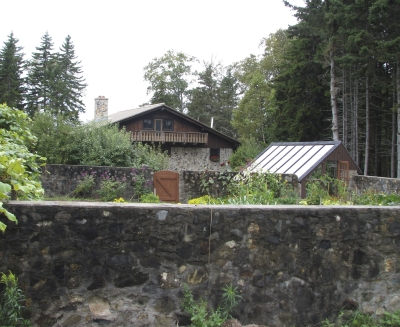 I had just dug my first garden which had a clay soil that turned rock hard as it dried, so I was especially awed, inspired, and admittedly jealous of the soft, crumbly ground in Scott’s garden. What a surprise when someone who had worked with Scott for a long period told me how tough and lean his soil had been when he started the garden. A number of giant compost piles were testimonial to what it takes to improve a soil.
I had just dug my first garden which had a clay soil that turned rock hard as it dried, so I was especially awed, inspired, and admittedly jealous of the soft, crumbly ground in Scott’s garden. What a surprise when someone who had worked with Scott for a long period told me how tough and lean his soil had been when he started the garden. A number of giant compost piles were testimonial to what it takes to improve a soil.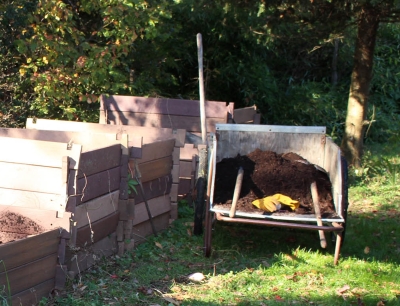 The soil in my permanent vegetable beds is never turned over with a rototiller or garden fork; instead, every year a layer of compost an inch or so deep is lathered atop each bed, and no one ever sets foot in a bed. That inch of compost snuffs out small weeds, protects the soil surface from washing away, and provides food myriad beneficial microbes (and, in turn, for the vegetable plants).
The soil in my permanent vegetable beds is never turned over with a rototiller or garden fork; instead, every year a layer of compost an inch or so deep is lathered atop each bed, and no one ever sets foot in a bed. That inch of compost snuffs out small weeds, protects the soil surface from washing away, and provides food myriad beneficial microbes (and, in turn, for the vegetable plants). Recent additions to that pile were an old soil pile from a local horse farm and soil from a hole I was digging to create a small duck pond. The latter was poorly aerated subsoil.
Recent additions to that pile were an old soil pile from a local horse farm and soil from a hole I was digging to create a small duck pond. The latter was poorly aerated subsoil.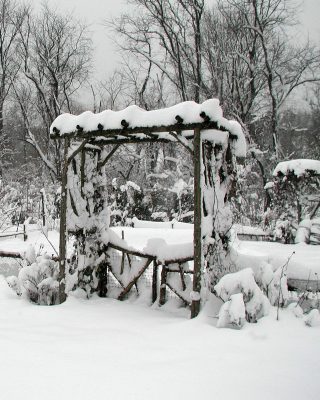
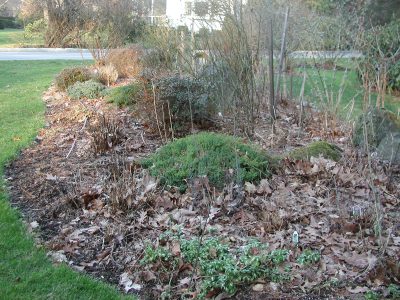
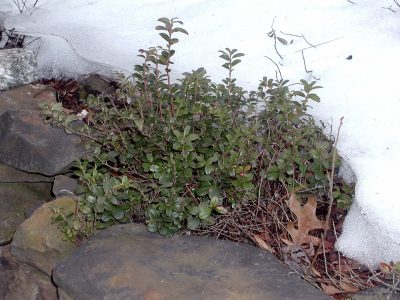
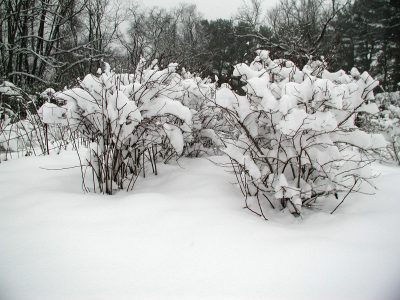
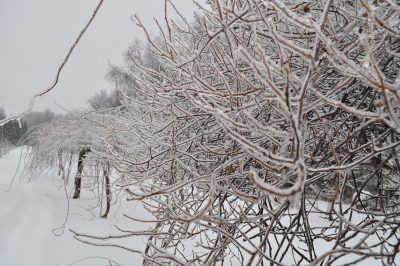
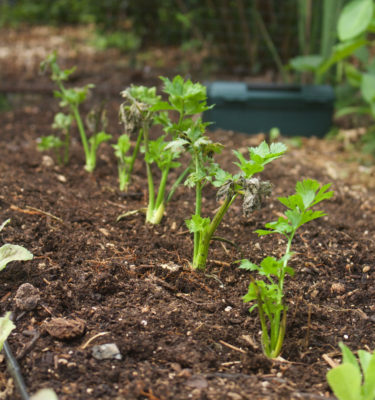
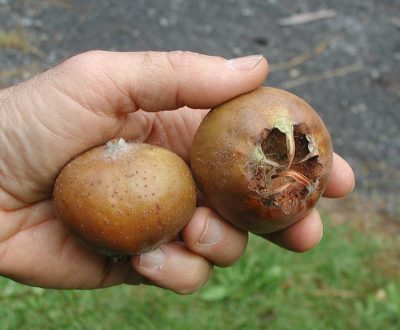 Usually the plant is pest-free but a few years ago something, perhaps a fungus, perhaps an insect, started attacking it, leaving the flesh dry and crumbly. I have yet to identify the culprit so that appropriate action can be taken.
Usually the plant is pest-free but a few years ago something, perhaps a fungus, perhaps an insect, started attacking it, leaving the flesh dry and crumbly. I have yet to identify the culprit so that appropriate action can be taken.